*** Updated for February 2025 ***
I first published this page in 9th July 2019.
My new schematics have been drawn from scratch and I have included:
- better resolution – they can be printed on A2 paper (23.4in x 16.5in) without any loss of quality.
- sized for UK and Europe – originally the page was sized for US Legal (14in x 8.5in) paper, and resizing for A4/A3/A2 standard didn’t work.
- cable colours were confusing – it was difficult to see what was the dominant colour ‘vs’ what was the trace colour.
- for MK3 move the key switch from the right to the left side of the page.
- show the warning lamp colours.
- lighter background – ideally there would be no background, but as there are a lot of white cables this would make it difficult to read. I have lightened up the background, and outlined the white cables, it works much better for printing now.
- make points/condenser arrangement clearer.
- show terminals on turn signal flasher unit.
- group additional fuses on early MK3 schematic.
- improved labelling.
There are numerous other small improvements too, which make the schematics easier to read.

This page covers two aftermarket upgrades seen on our Norton Commandos.
- PODtronics regulator/rectifier
- Tri-Spark electronic ignition.
Regulator/Rectifier

One of the most common upgrades or modifications for a classic british bike is to add a combined regulator/rectifier unit.
Our Commandos use a blue can capacitor, zener diode (which can be found mounted on the back of the z-plate) and rectifier unit.
A combined regulator/rectifier replaces all of these components with one package.
The most common manufacturer of these is PODtronics.
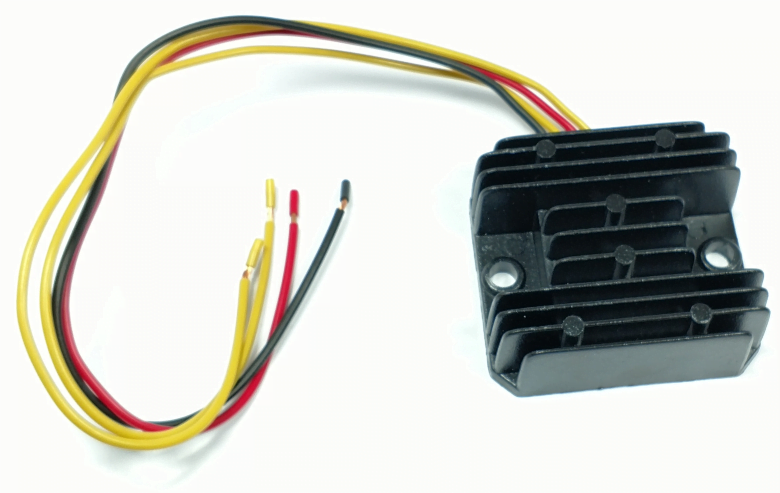
There are four wires to connect:
| Wire Colour | Description |
|---|---|
| Yellow (x 2) | these are the AC input and pick up on the Green/Yellow and White/Green (connection can be any way round, as this is the AC side of the circuit) |
| Red | this is the Positive output and will join to the red wire if you are using existing wiring (it goes straight to the ground/earth of the frame) |
| Black | this is the Negative output (known as the hot wire) – it will pick up on the Brown/Blue wire (which goes via a fuse straight to the battery negative terminal) |
Warning Light Assimilator
The factory warning light assimilator is not compatible with most modern regulator/rectifiers and the PODtronics is no exception so it has been removed from the schematics.
Plus, there is the matter of what the WLA is actually doing, and how much use that is.
The WLA is looking purely for some AC output from the alternator stator (about 6 ½ volts AC) it is not designed for a three phase stator either.
It gives you no information about the charging (i.e., the regulator (zeners) and rectifier)
It gives you no information about the state of the battery.
Charge Warning Light
I have taken the liberty of adding an ICM Charge Warning Light to the schematics – I can certainly recommend the Improving Classic Motorcycles charge warning light as a brilliant alternative.
I use them myself, and have had a good experience with them.
The nice thing about the Improving Classic Motorcycles unit is that you can retain the original warning light – so it looks totally factory (this for me is an important factor with the MK3 with it’s quirky little instrument panel).
It gives you a lot more useful information about the state of the battery and charging system compared to the standard assimilator unit, which looks for AC output from the alternator stator only.
Electronic Ignition

The new kid on the block for Electronic Ignitions is Tri-Spark.
Well, I say new kid – they have been around since about 2009.
You can find the Tri-Spark website here.
The Tri-Spark unit is a one box solution – all the gubbins are mounted inside the points cover – no additional black box to try and hide under the tank, and very very simple to connect up.
The wiring is as follows:
| Wire Colour | Description |
|---|---|
| Red | This is the positive feed to the Tri-Spark unit. Most people attach this wire to one of the two fixing posts inside the points cover. I would personally recommend running an additional wire up to the coils and have drawn the wiring diagrams accordingly. |
| Black/Yellow | This is the negative feed to the Tri-Spark unit. This joins in to the White/Blue wire that used to feed the Ballast Resistor that you are removing. As standard, this goes up to the big connector block under the tank, where it’s joined to the White/Yellow that is the kill switch on your left side handlebar switch cluster. |
| Black/White | This is the negative supply FROM the Tri-Spark TO the coils. |
As with the Boyer, from a wiring perspective, the most important thing to note is that you will be moving from a pair of coils that are wired in parallel to series.
Originally, the points make and break the positive (earth) side of each coil in turn.
The Tri-Spark electronic ignition system uses a concept called “wasted spark” – with the two coils wired in series, they are energized together on every rotation of the camshaft.
You’ll note in the wiring diagrams below that the Ballast Resistor and Condensers have been removed as part of the conversion to Electronic Ignition.
Two major benefits of the Tri-Spark:
- a very low operating voltage – as low as 8 volts means your bike will still run with a less than optimal battery and charging system
- circuitry performs the electronic equivalent of advance and retard to make the bike easier to start and stop the possibility of kick-back. This makes it gentler on your knees, and kinder to electric start systems (aka the delicate Commando sprag clutch)
1968 Norton Commando Wiring Schematic + Tri-Spark ignition AND PODtronics reg/rec
These are the pre-1971 bikes and have the ammeter in the headlight shell, as well as the Wipac Triconsul type handlebar switch.
The wiring is very simple, and more like the Atlas than what came to be familiar with the Commando.
Note that I have included the Front Brake Switch as standard – this was a US requirement, that didn’t appear on the earliest UK bikes.
1968 Norton Commando Wiring Schematic + Tri-Spark ignition AND PODtronics reg/rec PNG 5600×3960
This diagram is also downloadable as a PDF from HERE
1971 Norton Commando Wiring Schematic + Tri-Spark ignition AND PODtronics reg/rec
This is often referred to as the “Interim” model.
It is distinguishable by the three pin master switch (ignition key switch) which was Lucas part number LU39565.
These were made ONLY for the Norton Commando, and are no available as an aftermarket replacement.
If you are not comfortable rebuilding the switch, most people choose to go for the LU30552, which IS readily available.
You can find an article on ignition switches here, that may be of interest.
1971 Norton Commando Wiring Schematic + Tri-Spark ignition AND PODtronics reg/rec PNG 5600×3960
This diagram is also downloadable as a PDF from HERE
1972 onwards Norton Commando Wiring Schematic + Tri-Spark ignition AND PODtronics reg/rec
The 1972 onwards schematic covers 750 and 850 bikes and has the much more familiar four pin master switch (ignition key switch)
1972 onwards Norton Commando Wiring Schematic + Tri-Spark ignition AND PODtronics reg/rec PNG 5600×3960
This diagram is also downloadable as a PDF from HERE
MK3 Commando
During the manufacture of the MK3, Norton and Triumph were coming together, and they were often feeding from the same parts bins.
We have noted some anomalies between the handlebar switches while the MK3 was in production, as they frequently used the Triumph T140E switches, which look the same, but have a couple of small wiring differences.
Left handlebar switch the U (blue) used by Norton (and illustrated in the factory workshop manual) has been replaced with a UY (blue/yellow) cable. This connects to the U (blue) of the right handlebar switch inside the headlamp bucket.
Right handlebar switch there is no S (slate grey) instead, the single “hot” negative from the pin 2 of the Master Switch (ignition key switch) is jumpered for both engine run/kill switch and the starter button.
Another element of the MK3 that sometimes causes confusion is the wiring around the Warning lights.
The factory workshop manual shows the following:
I have covered this in more detail in a separate article, which can be found here.
But in short, the cable colors used for the sub-console wiring harness were not the same all the way through MK3 production – so certainly something to watch out for!
1974 Norton MK3 Commando (Early) Wiring Schematic + Tri-Spark ignition AND PODtronics reg/rec
1974 MK3 Early Bikes – there were around 2,000 bikes that were built around the December 1974 timeframe that have three additional fuses that can be found in the headlamp bucket.
1974 Norton MK3 Commando (Early) Wiring Schematic + Tri-Spark ignition AND PODtronics reg/rec PNG 5600×3960
This diagram is also downloadable as a PDF from HERE
1975 Norton MK3 Commando Wiring Schematic + Tri-Spark ignition AND PODtronics reg/rec
This is the most common configuration, and takes us through to the final Commando that rolls off the production line.
1975 Norton MK3 Commando Wiring Schematic + Tri-Spark ignition AND PODtronics reg/rec PNG 5600×3960
This diagram is also downloadable as a PDF from HERE
1975 Norton MK3 Commando (Canadian Market) Wiring Schematic + Tri-Spark ignition AND PODtronics reg/rec
For the Canadian Market, there were legal requirements around the headlamp being on while the engine was running.
A different Master Switch (ignition key switch) is fitted in order to adhere to law in Canada. More info is available here in a separate article.
This is covered in the Factory Wiring Diagram, by notes.
The Canadian key switch LU30825 is not available, and must be rebuilt manually.
1975 Norton MK3 Commando (Canadian Market) Wiring Schematic + Tri-Spark ignition AND PODtronics reg/rec PNG 5600×3960
This diagram is also downloadable as a PDF from HERE
NOTE:
A couple of points about the way these diagrams have been drawn:
- The diagrams on my site are schematics – the components are not drawn in the physical location on the bike. Instead they are drawn in locations that make the diagram the easiest and most logical to follow.
- Where the same colour wire goes in to and out of a single connector, that connector has usually been omitted from the drawing.
It’s obvious on the bike, is easy to spot and easy to troubleshoot.
Leaving them off the diagrams makes them a LOT easier to read, and considerably less cluttered. - Wherever the earth or ground side of a component goes back to the battery, the drawing shows a red earth symbol:

In reality, this could be connected either to a red wire in the bike’s wiring harness (loom) OR it could be attached to the frame or engine of the bike.
I have shown the red earth symbol each time in order to massively simplify the diagram, and make it a lot easier to understand for everyone.
I have also coloured them red as a gentle reminder that these bikes are wired positive earth!
Categories: Aftermarket Upgrades, motorcycles


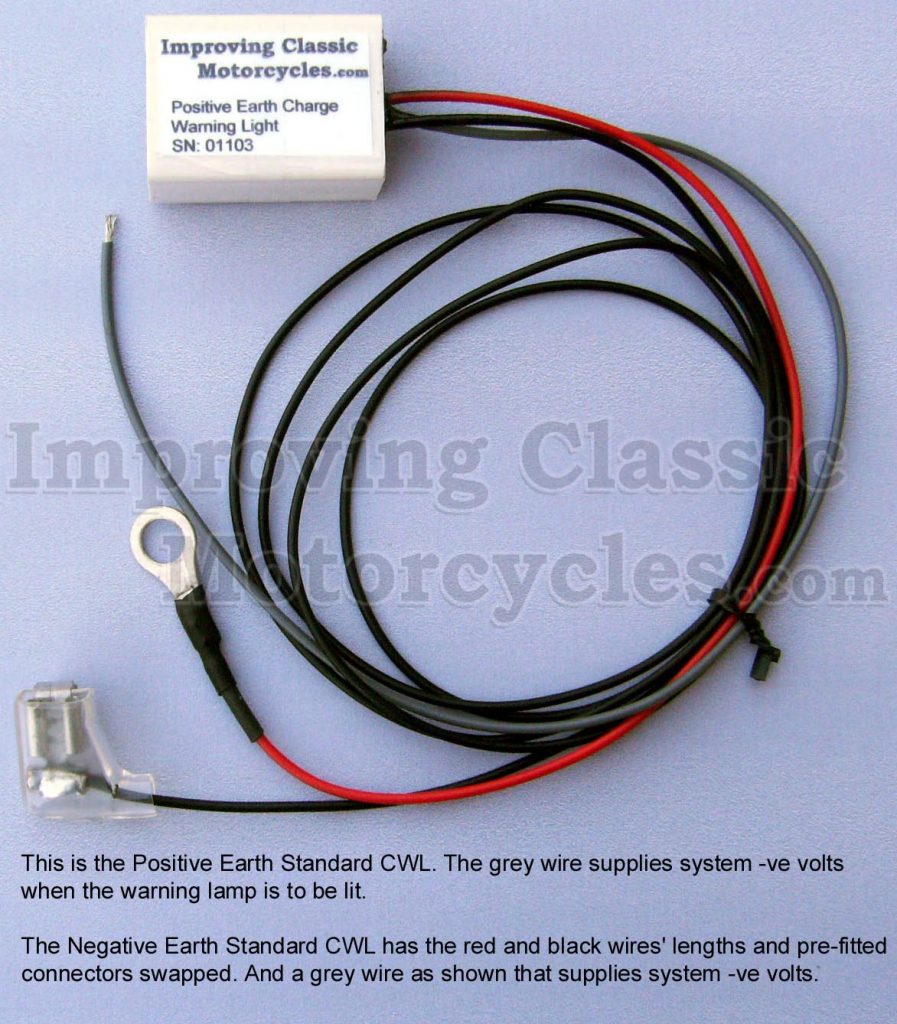
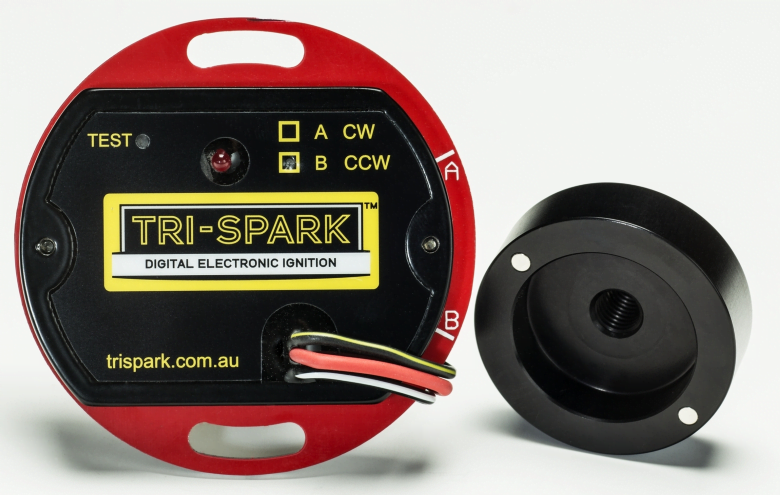


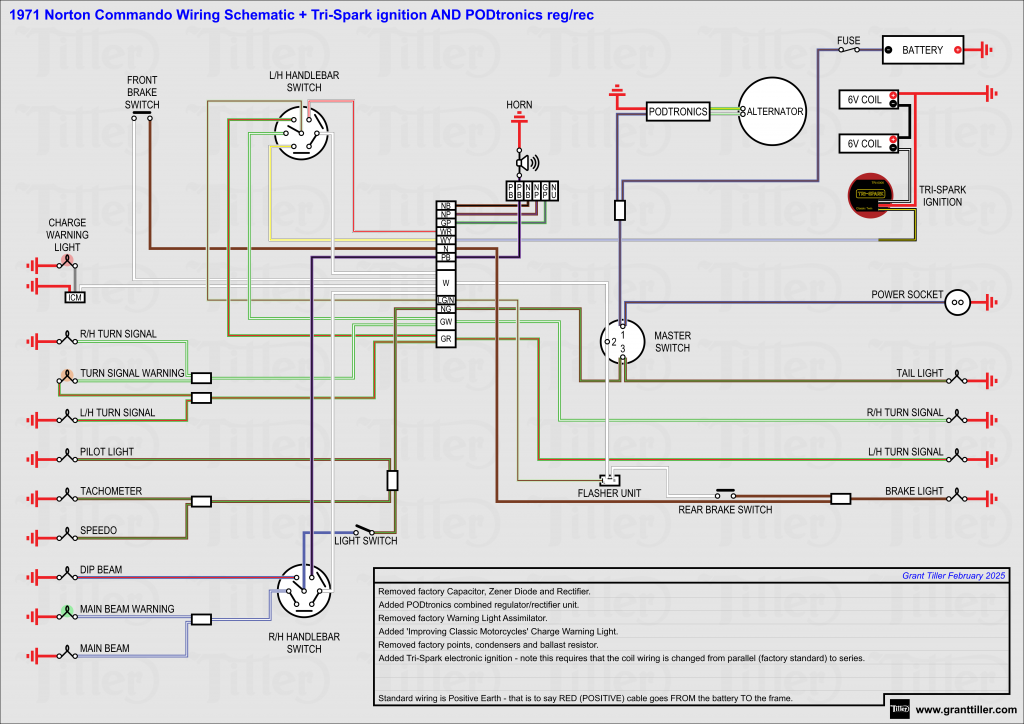
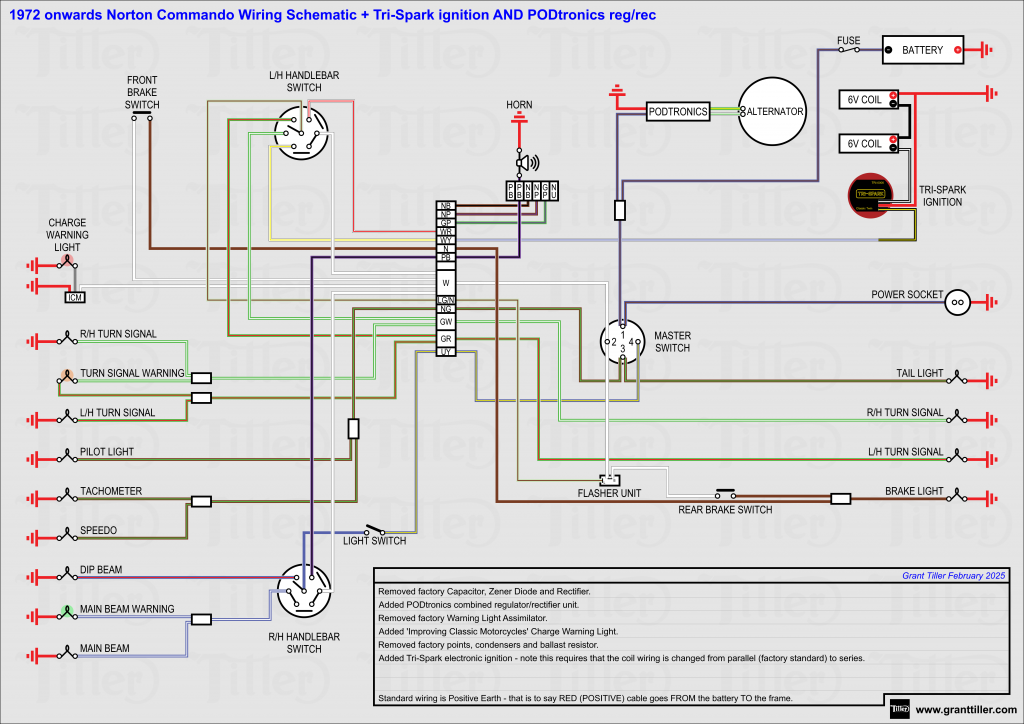



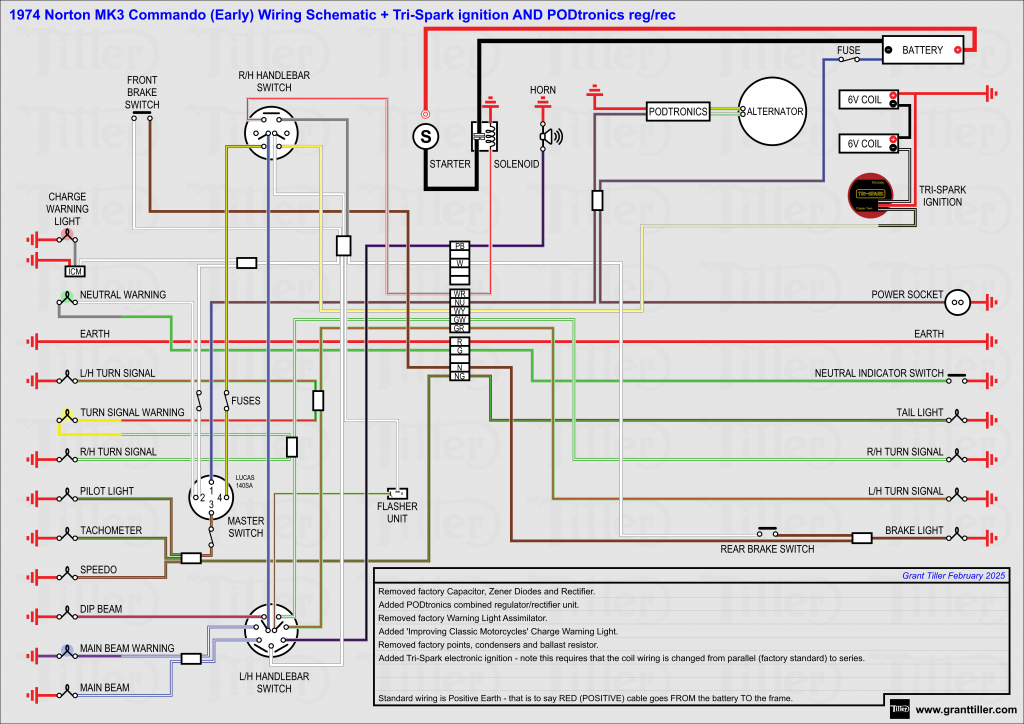
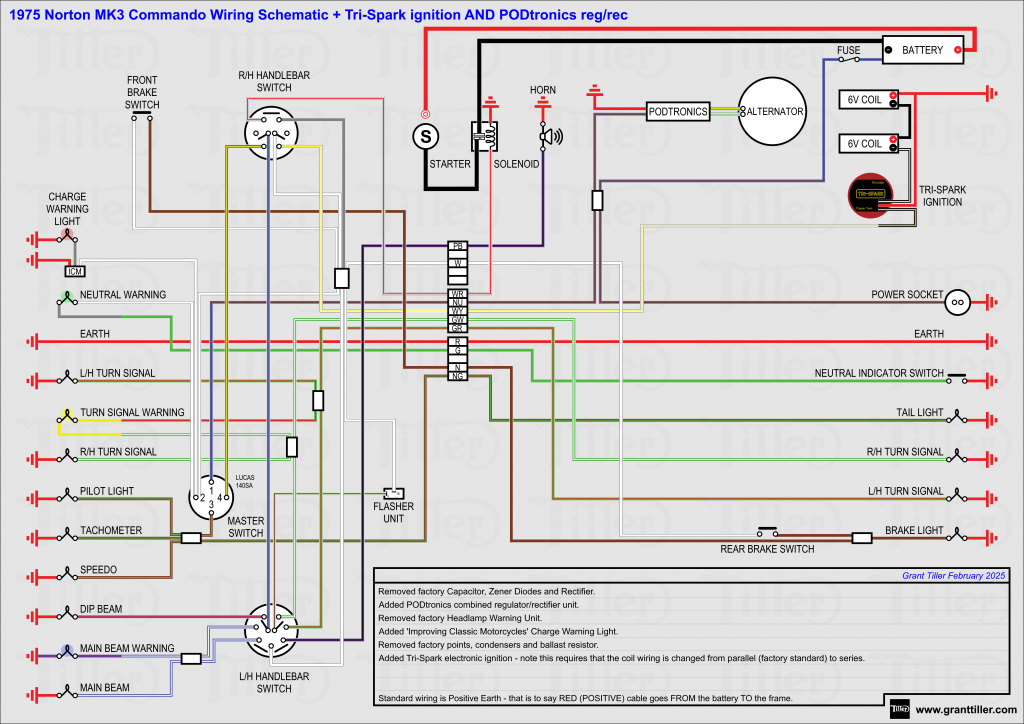
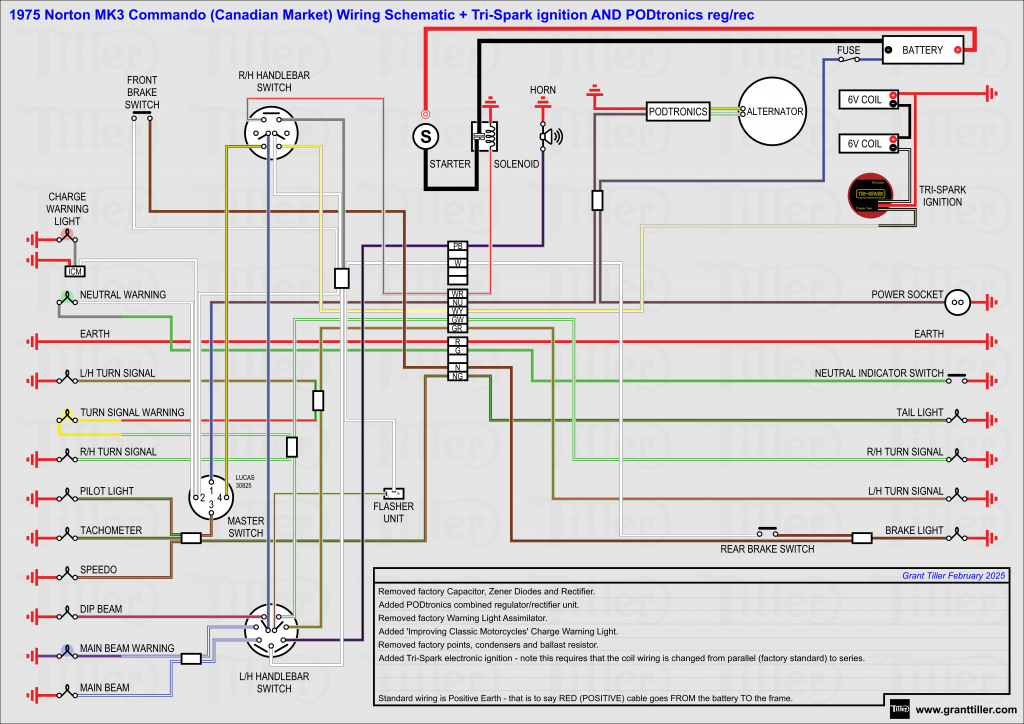
Thanks for the site, the wiring diagrams are brilliant and very helpful. Can you tell me what software they were made from, I would like to make one for my Triumph T160 Trident. Thanks
Thanks Simon,
Currently using Paint.NET which isd free, but very time consuming!
I tried CanvasGFX but during testing found an issue with grouped graphics dancing on the page – not good when you are drawing diodes or expect your wires to join up.
I was less than impressed with their support department, who wouldn’t acknowledge the issue until i sent them several files and videos of it actually happening.
If and when they fix it, i will switch over, as it’s an otherwise good product – and the only one I have found that lets me draw wires how I like to see them!
Thanks for the reply and information.
I have a 1977 Norton Commando MK 111 I have fitted a podtronics control unit but have no charge what do I have to remove to convert this to make it work I have removed all the original parts including the zener diodes and charge rectifier control but have left the capacitor in place. I also have fitted a pazone ignition set. Do I also have to disconnect the small connecting diode marked with w/lamp alt, etc,
If you could give me some advice it would be most helpful.
All the alternator part are new and have the correct air gap between stator and rotor.
Hi Bruce,
For the MK3, you will need to remove both zener diodes (there is one on each z-plate) as well as the half wave rectifier too.
It is recommended that you remove the blue can capacitor too, but it’s not totally necessary.
Hope this helps!
There is a daiagram for Pazon ignition and PODtronics reg/rec that can be found here:
https://granttiller.com/pazon-sure-fire-podtronics